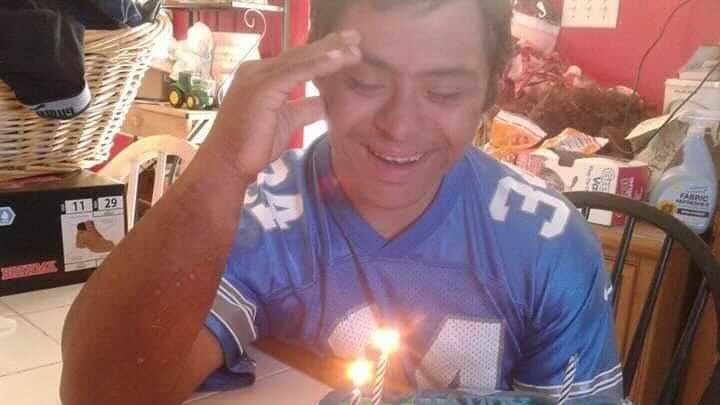William Reilly’s younger brother Vincent Welch, 35, has Down syndrome and lives at home with his mother in Snover, a farming community of fewer than 500 people in eastern Michigan. Welch rarely goes out, spending most of his time inside, watching television.
So even as the state and their community saw COVID-19 rates tick up in recent weeks, Reilly figured his brother was likely safe.
Instead, Welch is now fighting for his life on a ventilator after being airlifted to the hospital at the University of Michigan in Ann Arbor.
“He’d be the last person I’d ever expect it to happen to,” Reilly said from his home in Lawrence, Kansas.
Snover is near the top of the state’s geographical “thumb,” about 100 miles north of Detroit—an epicenter within the state and a key hotspot nationwide. Michigan has seen more than 47,000 new cases and a 16.4 percent positivity rate over the past seven days, according to Johns Hopkins University. And there have been, on average, 116.4 new daily cases per 100,000 people in Sanilac County—where Snover is located—over the past week, one of the highest rates in the country.
For Reilly, his mother, Susan Welch, and their beloved Vincent, the episode comes at an especially painful moment—with vaccines, and some assurance of safety, finally within reach.
“That’s all he talked about is getting a shot,” Susan Welch, 65, told The Daily Beast via text message.
The problem, she said, was a slow rollout that was just now beginning to make shots fully available in their community. She cited her employer, Walmart, as only getting “a few doses at a time.”
A spokesperson for the Sanilac County health department did not immediately respond to a request for comment. But a voice message at the department’s main phone number informed callers: “Due to the overwhelming COVID-19 vaccine requests, the department is pausing our appointment waiting list until further notice. As soon as the department has processed all the current requested appointments and has assurance that we will have an adequate vaccine supply, we will reopen the schedule for taking appointments.”
Welch recently had COVID herself. She suspects she got it on the job—she works as a greeter for the big box retailer—and that that’s how her son got it, too.
“I’m thinking it had to be at work,” she told Reilly in a text message he shared with The Daily Beast. “It was probably one time when I couldn’t, or forgot to, wash my hands.”
Susan’s symptoms were first misdiagnosed as the flu, she told The Daily Beast. Two days later, she had a stroke doctors told her was a byproduct of COVID, she said. About two weeks after she got out of the hospital, Vincent began to feel unwell. Although he didn’t have a fever, he began to experience chills.
“I sat my pop on the sink instead of dumping it out, he drank it,” Susan told The Daily Beast, thinking back on a time when she may have passed the virus to her son.
At one point soon after, when he got up to go to the bathroom, Vincent fell “flat on his face, turning blue,” Susan recalled. Since she was still very ill, another one of her 11 children drove Vincent to a small local hospital in Marlette, about eight miles away.
When Vincent began to have serious breathing problems, he was transferred by ambulance to a larger hospital in Saginaw, according to his mother. After 16 days in the COVID unit without any improvement, he was put under sedation, and doctors intubated him.
Then came the airlift to Ann Arbor.
Now the family is stuck in the dark, unable to visit because the state’s hospitals are locked down to protect against the latest surge.
Vincent, his brother said, “has shown no improvement since he got to Ann Arbor,”
“I have a really bad feeling about it,” he added.
A 2020 cohort study of 8 million adults found that people with Down syndrome who contract COVID are four times more likely to be hospitalized and 10 times more likely to die from the virus than members of the general population. The findings have since been supported by further research, according to Yale Medicine clinical geneticist Dr Michele Spencer-Manzon, who wrote that she has been counseling families to be extra-vigilant around their relatives with Down.
Meanwhile, Gov. Gretchen Whitmer has come under fire in recent days for loosening rules on indoor dining and allowing indoor school sports, both among factors experts say have stoked the resurgence of the pandemic in the state.
But another potential factor has little to do with the governor: families and students returning from spring break holidays. In St. Clair County, one of Michigan’s current hotspots and also located in “the Thumb,” the health department and local school district are hosting a “Welcome Back Spring Breakers” event on Sunday. It will consist of a mass, drive-up COVID testing clinic all afternoon at a local stadium.
Of course, most spring breakers aren’t bringing COVID on vacation with them but rather contracting it while they’re away and taking it home with them, Dr. Emily Landon, an infectious disease specialist at the University of Chicago, told The Daily Beast.
“So it’s not counted in Florida, but where you live,” she said. “Florida has the highest rate of variants in the country, because they have a lot of mixing by people who travel from other places to be there.”
Julia Ftacek, a graduate student and teacher at the University of Western Michigan in Kalamazoo, has been attending and teaching classes fully online. At the same time, many of her students have been on a hybrid model. But the pupils returned this week from spring break to 100 percent online instruction, part of a plan by the school to avoid the spread of COVID by those returning to campus infected.
Even with that plan in place, the virus continues to find more than enough willing hosts in her community.
“After we kind of felt like things were on the upswing, seeing the spike in cases has been really horrible,” Ftacek told The Daily Beast. “I feel terrible for my students—they don’t always have a choice whether they can be online or in-person. I’m teaching freshmen and sophomores, and this is their first experience with college.”
Back in Ann Arbor, William Reilly’s brother Vincent continues to struggle, he said. It’s been five days since Vincent arrived, and doctors hope to remove his breathing tube on Wednesday and perform a tracheotomy, according to his mother.
“We requested that they play country music in his room because with his Down’s and special needs, we were thinking that might stimulate his brain,” Susan Welch told The Daily Beast. “Just a while ago, we got a message that he is responding to the music. So that is all we know right now.”
At this point, there’s no time for what ifs or blame. Just fear.
As Reilly put it, “I hope we don’t lose him.”







